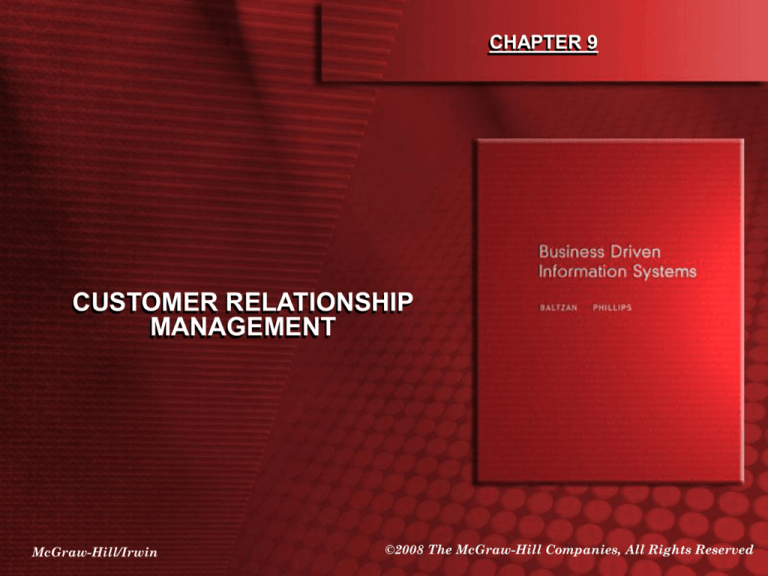
CHAPTER 9
CUSTOMER RELATIONSHIP
MANAGEMENT
McGraw-Hill/Irwin
©2008 The McGraw-Hill Companies, All Rights Reserved
Customer Relationship Management Overview
Chapter Nine Overview
•
SECTION 9.1 – CUSTOMER RELATIONSHIP MANAGEMENT
– Business Benefits of CRM
– Using Information Technology to Drive Operational CRM
– Using Information Technology to Driver Analytical CRM
•
SECTION 9.2 – CUSTOMER RELATINSHIP MANAGEMENT STRATEGIES
– Customer Relationship Management’s Explosive Growth
– Customer Relationship Management Success Factors
– Current Trends: SRM, PRM, ERM
– Future CRM Trends
ITO 07-06-13 Bild 9-2
9.1.1 CUSTOMER RELATIONSHIP MANAGEMENT
•
CRM enables an organization to:
– Provide better customer service
– Make call centers more efficient
– Cross sell products more effectively
– Help sales staff close deals faster
– Simplify marketing and sales processes
– Discover new customers
– Increase customer revenues
ITO 07-06-13 Bild 9-3
Crm basics
•
Organizations can find their most valuable customers through “RFM” Recency, Frequency, and Monetary value
– How recently a customer purchased items (Recency)
– How frequently a customer purchased items (Frequency)
– How much a customer spends on each purchase (Monetary Value)
ITO 07-06-13 Bild 9-4
The Evolution of CRM
•
Three phases in the evolution of CRM include reporting, analyzing, and
predicting
ITO 07-06-13 Bild 9-5
The Evolution of CRM
ITO 07-06-13 Bild 9-6
Operational and Analytical CRM
ITO 07-06-13 Bild 9-7
Using IT to Drive Operational CRM
ITO 07-06-13 Bild 9-8
Sales and Operational CRM
•
The sales department was the first to begin developing CRM systems with
sales force automation – a system that automatically tracks all of the steps
in the sales process
ITO 07-06-13 Bild 9-9
Using IT to drive analytical CRM
•
Personalization – when a Web site knows enough about a persons likes
and dislikes that it can fashion offers that are more likely to appeal to that
person
•
Analytical CRM relies heavily on data warehousing technologies and
business intelligence to glean insights into customer behavior
•
These systems quickly aggregate, analyze, and disseminate customer
information throughout an organization
ITO 07-06-13 Bild 9-10
Using IT to drive analytical CRM
•
Analytical CRM information examples
1.
Give customers more of what they want
2.
Value their time
3.
Overdeliver
4.
Contact frequently
5.
Generate a trustworthy mailing list
6.
Follow up
ITO 07-06-13 Bild 9-11
9.2. CUSTOMER RELATIONSHIP MANAGEMENT
STRATEGIES
CRM Business Drivers
ITO 07-06-13 Bild 9-12
Customer relationship management’s success factors
•
CRM success factors include:
1.
Clearly communicate the CRM strategy
2.
Define information needs and flows
3.
Build an integrated view of the customer
4.
Implement in iterations
5.
Scalability for organizational growth
ITO 07-06-13 Bild 9-13
Current trends: SRM, PRM, AND ERM
•
Current trends include:
–
Supplier relationship management (SRM) – focuses on keeping
suppliers satisfied by evaluating and categorizing suppliers for
different projects, which optimizes supplier selection
–
Partner relationship management (PRM) – focuses on keeping
vendors satisfied by managing alliance partner and reseller
relationship that provide customers with the optimal sales channel
–
Employee relationship management (ERM) – provides employees
with a subset of CRM applications available through a Web browser
ITO 07-06-13 Bild 9-14
Future CRM trends
•
CRM future trends include:
–
CRM applications will change from employee-only tools to tools used
by suppliers, partners, and even customers
–
CRM will continue to be a major strategic focus for companies
–
CRM applications will continue to adapt wireless capabilities
supporting mobile sales and mobile customers
–
CRM suites will incorporate PRM and SRM modules
ITO 07-06-13 Bild 9-15








